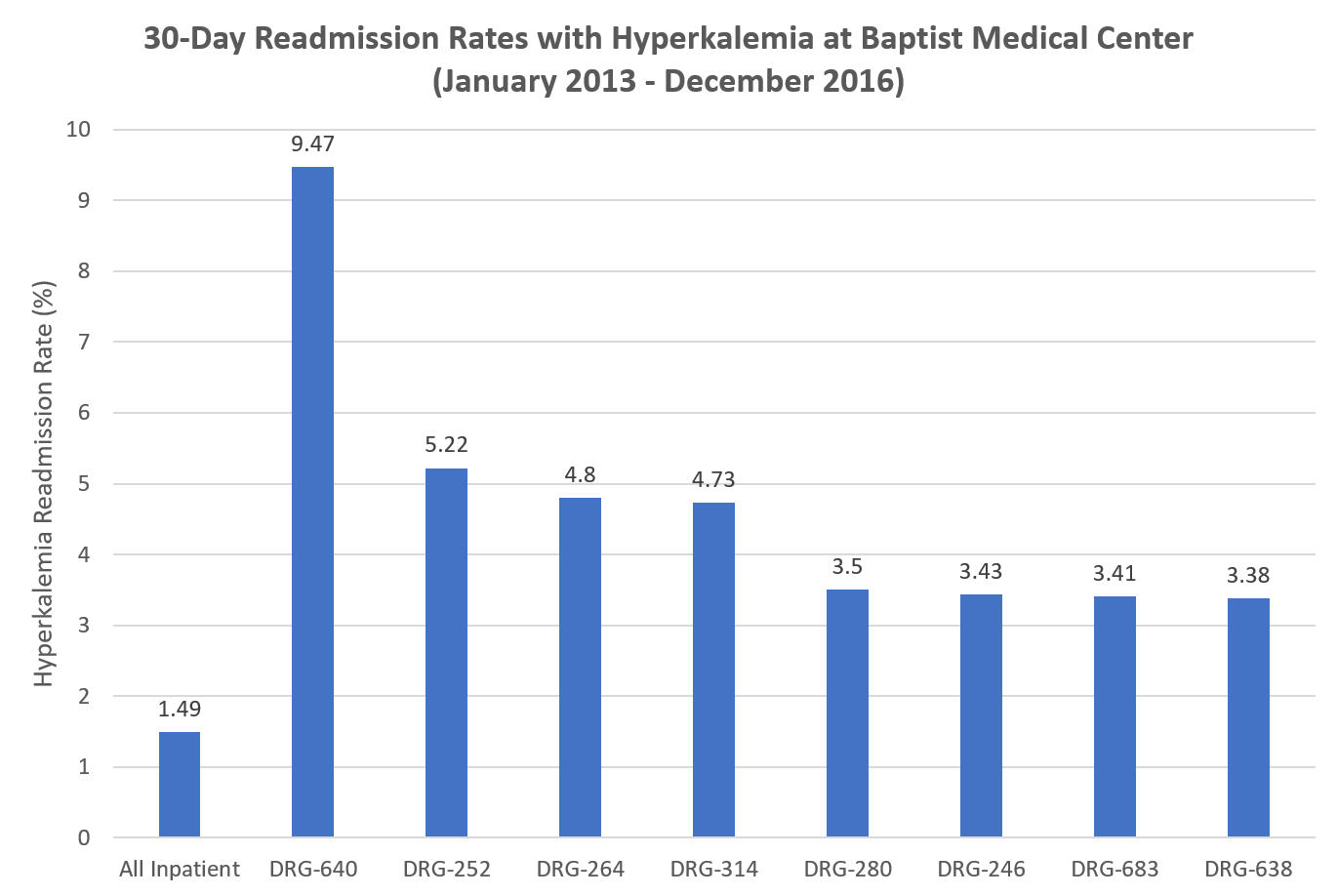Veltassa’s Potential Regarding Hyperkalemia Readmissions: Analysis of Baptist Medical Center Discharges
In Veltassa, Hyperkalemia
Get Dexur’s Personalized Hospital Specific Presentation on Quality, Safety, Compliance & Education
By: Jeffrey Maser Mar. 29, 2018
Veltassa (patiromer), by Relypsa, is a prescription medication taken to reduce high levels of potassium in a patient's blood, a condition known as hyperkalemia. Patients with chronic kidney disease (CKD) are especially at risk for hyperkalemia, as research shows the incidence of hyperkalemia as high as 40-50% in patients with CKD, compared to only 2-3% of the general population. CKD patients at the highest risk for hyperkalemia include those with diabetes, cardiovascular disease, advanced CKD, transplant recipients and/or those taking renin-angiotensin aldosterone system (RAAS) inhibitors. One caveat here is that the CKD patients who are treated with RAAS inhibitors are the same patients who benefit most from this treatment. Such information underlines the need for effective hyperkalemia treatments, especially in patients with CKD.
A February 2017 study of 12 medications commonly used in treating hyperkalemic patients with CKD showed minimal risk for drug-drug interactions with Veltassa when the drugs were administered 3 hours apart. Lance Berman, M.D., Chief Medical Officer of Relypsa noted that this increases "flexibility in selecting Veltassa for patients with hyperkalemia and adding it to their daily treatment regimen." Additionally, results from a phase 4 study this past April indicate that Veltassa can be taken with or without food to produce its desired potassium-lowering effect, further adding to the flexibility in incorporating Veltassa in hyperkalemic patients' daily treatment regimens. Alain Romero, Ph.D., Pharm.D., Vice President, Medical and Scientific Affairs at Relypsa commented that Relypsa is "preparing a supplemental New Drug Application based on these findings."
Dexur analysts examined Medicare inpatient discharges at Baptist Medical Center in San Antonio, Texas between 2013-2016 to better understand the potential quality and cost benefits of an effective treatment for patients with hyperkalemia. Of the 62,521 total inpatient discharges (excluding transfers, discharges against medical advice, and patient deaths) from the hospital, there were 4,551 discharges with hyperkalemia, accounting for 7.28% of the total inpatient volume. Furthermore, the hyperkalemia readmission rate, which is defined as readmissions with hyperkalemia divided by total discharges, was 1.49% for all inpatient discharges at the hospital. However, the readmission rate with hyperkalemia was significantly higher for a number of conditions.

| Diagnosis Related Group | Baptist Medical Center 30-Day Hyperkalemia Readmission Rate (%) |
|---|---|
| DRG-640: Miscellaneous Disorders Of Nutrition, Metabolism, Fluids And Electrolytes With Major Complication Or Comorbidity | 9.47 |
| DRG-252: Other Vascular Procedures With Major Complication Or Comorbidity | 5.22 |
| DRG-264: Other Circulatory System O.R. Procedures | 4.80 |
| DRG-314: Other Circulatory System Diagnoses With Major Complication Or Comorbidity | 4.73 |
| DRG-280: Acute Myocardial Infarction, Discharged Alive With Major Complication Or Comorbidity | 3.50 |
| DRG-246: Percutaneous Cardiovascular Procedures With Drug-Eluting Stent With Major Complication Or Comorbidity Or 4+ Vessels Or Stents | 3.43 |
| DRG-683: Renal Failure With Complication Or Comorbidity | 3.41 |
| DRG-638: Diabetes With Complication Or Comorbidity | 3.38 |
Hyperkalemia is categorized under Nutritional and Metabolic Disorders, which, unsurprisingly, had one of the highest readmission rates with hyperkalemia at Baptist Medical Center at 6.26%. DRG-640 (Miscellaneous Disorders Of Nutrition, Metabolism, Fluids And Electrolytes With Major Complication or Comorbidity), which falls within this condition, had a 9.47% readmission rate with hyperkalemia, the highest rate of any diagnosis related group at the hospital. Renal failure discharges, which include patients with chronic kidney disease, had a hyperkalemia readmission rate of 2.94%. DRG-683 (Renal Failure With Complication or Comorbidity), specifically, had a readmission rate of 3.41% with hyperkalemia. A few other diagnosis related groups with high hyperkalemia readmission rates include DRG-252 (Other Vascular Procedures With Major Complication or Comorbidity) at 5.22%, DRG-264 (Other Circulatory System O.R. Procedures) at 4.80% and DRG-638 (Diabetes With Complication or Comorbidity) at 3.38%.
DEXUR PRO MEMBERS GET ACCESS TO:
- Baptist Medical Center 30-Day Hyperkalemia Readmission Rate, Texas 30-Day Hyperkalemia Readmission Rate and National 30-Day Hyperkalemia Readmission Rate for 14 Select DRGs between January 2013 - December 2016
ABOUT THE AUTHOR
